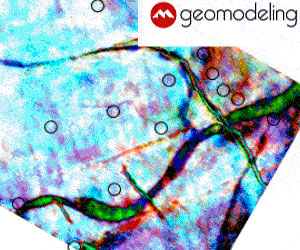Articles

Visualization Centres
Gordon Cope
Recently, the CSEG Continuing Education Committee organized a tour of five visualization centres in the downtown core. The Recorder reports on their unique features and focus.
...
An Interview with Elaine Honsberger, P.Geoph. Chair of APEGGA’s Geoscience Task Force
Nordahl Flakstad
For the last two years, a Geoscience Task Force struck by APEGGA Council has sought ways to make geologists and geophysicists feel they are more a part of the Association. The current Task Force Chair, Elaine Honsberger, P.Geoph., recently shared some thoughts on what has been accomplished and on what…

Depth Imaging of Foothills Seismic Data
Larry Lines, Samuel Gray and Don Lawton
Our CSEG luncheon talk (October 11, 2000) will give highlights of the CSEG publication entitled “Depth Imaging of Foothills Seismic Data”. The book and its accompanying short course (given at five Canadian universities) were both products of a CSEG Superfund Project and a CSEG Fiftieth Anniversary Project. The talk will…

B2B and the Oilpatch
Gordon Cope
Business to Business (B2B) is exploding in the oilpatch. How will geophysicists be affected? B2B is the buying and selling of raw materials, finished goods, information and services between companies over the Internet. For instance, B2B systems allow firms to electronically purchase everything from pencils and paper to seismic lines…

Acquisition Footprint – Its Detection and Removal
Satinder Chopra and Glen Larsen
Acquisition footprint is a term used to define linear spatial grid patterns seen on 3D seismic time slices. These patterns tend to ‘mirror’ parts of the acquisition geometry used for acquiring the seismic survey. They may be seen usually on shallow time slices or horizon amplitude maps as striations masking…

CSEG By-Laws
The original Bylaws were registered with the Registrar of Companies on August 8, 1977. Amendments to the bylaws were approved by extraordinary resolutions on December 13, 1977 and April 13, 1978. These amendments were registered on September 18, 1978. Further amendments were recommended and accepted by the Executive on August…

Proposed Amendments to CSEG By-Laws
Printed here are a series of amendments to the current bylaws of our society. Ashort explanation of the reasons behind the changes is in order. (October 2000)
...
Achieving Consistent and Stable Phase with Mixed-Source Surveys
Douglas Hart and Bruce Hootman
So as to minimize the cost of data acquisition, the use of different seismic sources is common in land and marine transition zone surveys. Mixed sources within a survey, however, introduce complications to the data processing effort. Similar difficulties arise when merging 3-D surveys. A key issue to address, in…

The Great Seismic Round-Up: The Canadian Forest Oil Story
D. Uffen, L. Michetti, L. Dickson, J. Churchill, J. Hay, L. Geck and A.Janzen
Seismic data may be the least understood commodity within the oil industry. The evolution of seismic technology has seen seismic data take greater prominence in developing prospects to mitigate drilling risk. This has led to widespread use of seismic data and a proliferation of companies with ownership rights. The practiced…

Does the Physics of an Exploration Play Support AVO Analysis in Prospect Evaluation?
Yongyi Li, Lee Hunt and Jonathan Downton
Whenever a new exploration play is brought to a geophysicist the question of its seismic explorability is posed. This question must be answered quickly and accurately because the explorability determines how the play will be pursued or even if it will be pursued. Given the current interest in lithology and…

Inversion of Multi-Offset VSP Traveltimes for Anisotropic Parameters: Plains Example
Rachel Newrick, Don Lawton and Deborah Spratt
First arrival traveltimes from a multi-offset vertical seismic profile (VSP) in the Alberta Basin were modelled to determine the Thomsen anisotropic parameters of clastic Mesozoic rocks. The solution was found to be non-unique. Traveltime data were modelled successfully using either a geologically determined or arbitrarily divided horizontally stratified earth. Anisotropy…

Borehole Seismology – The Tool for Reservoir Characterization and Monitoring
Björn N.P. Paulsson
Borehole seismology is rapidly advancing in a number of key areas. The first example of new instrumentation for borehole seismic surveys is the 80 level, three-component, clamped borehole seismic receiver array developed by P/GSI. The most recent survey, shot in December 1999 in PanCanadian’s Weyburn Field in Saskatchewan, is a…

16th World Petroleum Congress
Gordon Cope
The WPC was founded in London in 1933 as a worldwide forum for the oil and gas industry. It focuses on improving the management of petroleum resources through technology and the exchange of ideas and information. The theme of this year’s congress is; Petroleum for global development; networking people, business…

The Seismic Signature of Meteorite Impact Craters
M.J. Mazur, R.R. Stewart and A.R. Hildebrand
The sky is falling! The sky is falling! Well, not usually, but Chicken Little is occasionally right. There are times when stones and ice do fall from the sky. And if they’re big enough, they’ll excavate major cavities on impact. After erosion, infilling, and burial, these impact craters can become…

Izmit – Turkey Earthquake August 1999
Turgay Ogut
Earthquakes are the worst of the natural disasters. Because of their overwhelming power and the damage that they cause, men have been studying them for centuries. The first earthquake observatory was established during the East Hun Dynasty of China in 132 AD. The first (?) seismologist Heng Chang used a…

GeoCanada 2000 Luncheons
An overview of luncheons offered at GeoCanada 2000.
...
Using In-Situ Stress and Rock Mechanical Properties to Plan Your Best Well Trajectory with STABView™
Pat McLellan and Chris Hawkes
Advanced Geotechnology are the developers of STABView™, a Windows-based software package for evaluating borehole stability, lost circulation and sand production risks for vertical, deviated and horizontal wells in a wide variety of geological settings. In many sedimentary basins, especially in tectonically deformed strata or deep offshore settings, and those possessing…

Internet Delivery of High Resolution Aerial Ortho-Imagery
Larry Herdand and John Welter
The planning, organization and management of hydrocarbon exploration and exploitation operations requires accurate, complete and current maps illustrating the topography and surface features whether man made or natural. This information is invaluable for seismic planning and operations, well site planning and facility engineering. All aspects of surface activity from planning…

International Hot Spots 2000
Gordon Cope
The preceding year has brought a raft of changes to the international exploration picture; the CSEG Recorder looks at some of the hot-spots, not-spots and up-and-comers for the year. Since early 1999, the price of oil has almost tripled, but seismic exploration has lagged. “It’s better this year, the only…

Static Corrections for the 21st Century
Mike Cox
Static corrections are routinely applied to almost all surveys. In the past, the main emphasis has been for the computation and application of datum and residual static corrections on land and transition zone surveys. For marine surveys, static corrections are used to adjust the data to a sea-level datum with…









